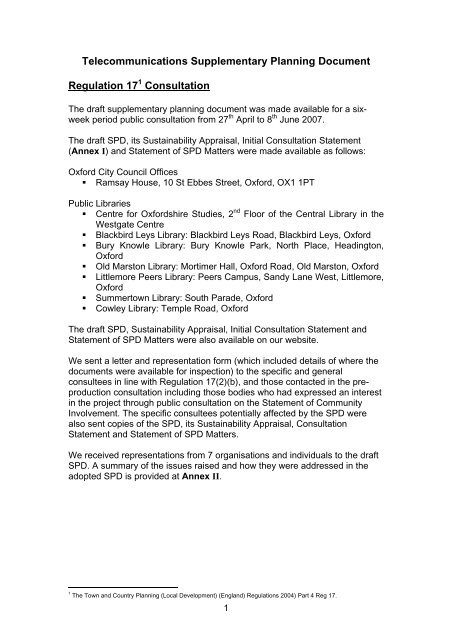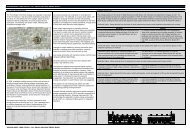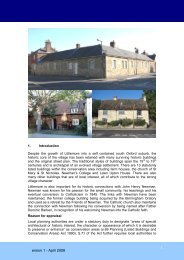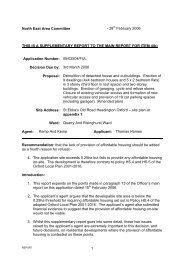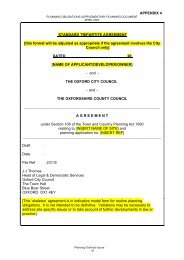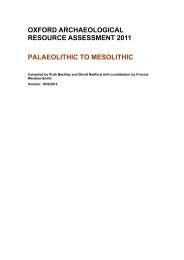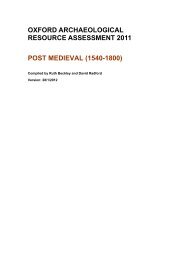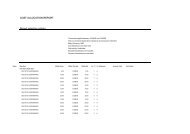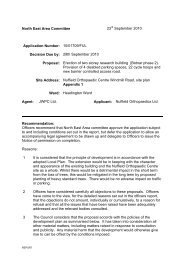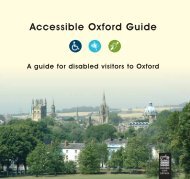SPD Consultation Statement - Oxford City Council
SPD Consultation Statement - Oxford City Council
SPD Consultation Statement - Oxford City Council
You also want an ePaper? Increase the reach of your titles
YUMPU automatically turns print PDFs into web optimized ePapers that Google loves.
Telecommunications Supplementary Planning Document<br />
Regulation 17 1 <strong>Consultation</strong><br />
The draft supplementary planning document was made available for a sixweek<br />
period public consultation from 27 th April to 8 th June 2007.<br />
The draft <strong>SPD</strong>, its Sustainability Appraisal, Initial <strong>Consultation</strong> <strong>Statement</strong><br />
(Annex I) and <strong>Statement</strong> of <strong>SPD</strong> Matters were made available as follows:<br />
<strong>Oxford</strong> <strong>City</strong> <strong>Council</strong> Offices<br />
� Ramsay House, 10 St Ebbes Street, <strong>Oxford</strong>, OX1 1PT<br />
Public Libraries<br />
� Centre for <strong>Oxford</strong>shire Studies, 2 nd Floor of the Central Library in the<br />
Westgate Centre<br />
� Blackbird Leys Library: Blackbird Leys Road, Blackbird Leys, <strong>Oxford</strong><br />
� Bury Knowle Library: Bury Knowle Park, North Place, Headington,<br />
<strong>Oxford</strong><br />
� Old Marston Library: Mortimer Hall, <strong>Oxford</strong> Road, Old Marston, <strong>Oxford</strong><br />
� Littlemore Peers Library: Peers Campus, Sandy Lane West, Littlemore,<br />
<strong>Oxford</strong><br />
� Summertown Library: South Parade, <strong>Oxford</strong><br />
� Cowley Library: Temple Road, <strong>Oxford</strong><br />
The draft <strong>SPD</strong>, Sustainability Appraisal, Initial <strong>Consultation</strong> <strong>Statement</strong> and<br />
<strong>Statement</strong> of <strong>SPD</strong> Matters were also available on our website.<br />
We sent a letter and representation form (which included details of where the<br />
documents were available for inspection) to the specific and general<br />
consultees in line with Regulation 17(2)(b), and those contacted in the preproduction<br />
consultation including those bodies who had expressed an interest<br />
in the project through public consultation on the <strong>Statement</strong> of Community<br />
Involvement. The specific consultees potentially affected by the <strong>SPD</strong> were<br />
also sent copies of the <strong>SPD</strong>, its Sustainability Appraisal, <strong>Consultation</strong><br />
<strong>Statement</strong> and <strong>Statement</strong> of <strong>SPD</strong> Matters.<br />
We received representations from 7 organisations and individuals to the draft<br />
<strong>SPD</strong>. A summary of the issues raised and how they were addressed in the<br />
adopted <strong>SPD</strong> is provided at Annex II.<br />
1 The Town and Country Planning (Local Development) (England) Regulations 2004) Part 4 Reg 17.<br />
1
<strong>Oxford</strong> <strong>City</strong> <strong>Council</strong><br />
2<br />
ANNEX I<br />
Telecommunications Supplementary Planning Document<br />
INITIAL STATEMENT OF CONSULTATION (Regulation 17 2 )<br />
Pre-prodution Stage<br />
Before preparing the Telecommunications Supplementary Planning Document<br />
(<strong>SPD</strong>), a briefing note was prepared which set out a summary background<br />
and scope of issues proposed to be addressed. These were sent to over 300<br />
prospective stakeholders (listed in Appendix A). The Planning Control User<br />
Group Panel were also informed of the commencement of preparation of the<br />
<strong>SPD</strong>.<br />
Following circulation of the briefing note, two stakeholder workshop sessions<br />
were held. The first workshop session was for representatives of the mobile<br />
phone network operators, and was well attended. Invitees to the second<br />
workshop included all elected <strong>City</strong> <strong>Council</strong> members, and community contacts<br />
who could be identified as having a particular interest in telecommunications<br />
development. Both workshops provided useful feedback and a further steer<br />
for preparation of the <strong>SPD</strong>. See Appendix B for a full list of workshop<br />
attendees.<br />
A working draft of the <strong>SPD</strong> was circulated to the <strong>City</strong> <strong>Council</strong>’s six Area<br />
Committees for comment (although only five commented). The comments<br />
made, and the lead officer response, are set out in Appendix C.<br />
These approaches accorded with the methods set out for <strong>SPD</strong> preparation in<br />
the adopted <strong>Statement</strong> of Community Involvement (SCI).<br />
There was a very low response to the briefing note mail-out, although detailed<br />
written comments were returned by the Mobile Operator’s Association (MOA)<br />
on behalf of the mobile operators. A number of key issues were also identified<br />
from the stakeholder workshops. These are summarised below. The way in<br />
which these have been addressed in the <strong>SPD</strong> is also outlined.<br />
Mobile Operators’ Association (on behalf of the network operators)<br />
Key issue of concern<br />
Objection in principle to Health<br />
and Radiation Impact Analysis<br />
(HRIA). The term itself is<br />
considered unhelpful, and<br />
issues of health relating to<br />
electromagnetic radiation should<br />
remain in the hands of the<br />
experts, which is identified by<br />
How the issue has been addressed<br />
The principle of HRIA was considered at<br />
the <strong>Oxford</strong> Local Plan Inquiry in 2004.<br />
The Inquiry Inspector supported inclusion<br />
of the requirement for HRIA in Policy<br />
CP.24 of the <strong>Oxford</strong> Local Plan 2001-<br />
2016, hence this is now adopted policy.<br />
The <strong>SPD</strong> has however been carefully<br />
drafted to ensure the requirement for<br />
2 The Town and Country Planning (Local Development) (England) Regulations 2004) Part 4 Reg 17.
Government as ICNIRP. Thus<br />
HRIA should only make<br />
reference to technical<br />
information already submitted as<br />
a matter of course, although<br />
submission of information on<br />
radiofrequency profiles would be<br />
considered as an informal<br />
submission, on a case-by-case<br />
basis.<br />
Stressed that operators are<br />
unable to take account of all<br />
background sources of<br />
radiofrequency in estimating<br />
cumulative emission levels near<br />
base stations, although some<br />
allowance is made for these in<br />
considering compliance to<br />
ICNIRP standards.<br />
Opportunity for annual rollout<br />
discussions welcomed, and an<br />
agreed protocol for preapplication<br />
discussion also<br />
supported.<br />
Comment that it will not always<br />
be possible to provide written<br />
confirmation of a landowner’s<br />
unwillingness to provide a site,<br />
as part of the alternative site<br />
assessment. However<br />
agreement that a robust<br />
justification for rejection of sites<br />
is appropriate.<br />
Comment that mast sharing may<br />
not always be appropriate in<br />
terms of design. Similarly, it will<br />
not always be appropriate to<br />
provide additional mast capacity<br />
for future users.<br />
Community stakeholders<br />
Key issue of concern<br />
Comment that Wi-fi, Network<br />
Rail and TETRA networks<br />
should also be considered in<br />
<strong>SPD</strong>.<br />
HRIA is a positive tool for addressing<br />
people’s health concerns.<br />
This point is recognised in the wording of<br />
the <strong>SPD</strong> where it deals with HRIA<br />
requirements.<br />
These issues are dealt with in detail in<br />
Section 3 of the <strong>SPD</strong>.<br />
This comment has been noted, and a<br />
procedure to ensure that alternative site<br />
assessment information required is<br />
transparent and fair to all concerned is<br />
included in Section 4 of the <strong>SPD</strong>.<br />
Section 4 of the <strong>SPD</strong> deals with design<br />
issues. The advice as drafted takes into<br />
account design and technical constraints,<br />
whilst stressing the need to consider<br />
future network capacity needs, and to<br />
seek site or mast sharing wherever<br />
possible, for each proposal considered.<br />
How the issue has been addressed<br />
The <strong>SPD</strong> deals primarily with the<br />
standard GSM and UTMS networks as<br />
these systems are responsible for almost<br />
all submissions to the planning<br />
department. However reference to these<br />
additional operating systems is made in<br />
Section 1 of the <strong>SPD</strong>.<br />
3
Comment that re-use of<br />
redundant sites should be<br />
encouraged.<br />
Request that annual rollout<br />
plans should be publicly<br />
accessible.<br />
Comment that community<br />
consultation is a key issue – this<br />
should be consistent for all<br />
applications, including proposals<br />
which fall under permitted<br />
development.<br />
Doubt expressed over<br />
thoroughness of alternative site<br />
assessment in practice.<br />
Proximity of schools etc. should<br />
be considered at this stage.<br />
Comment that taller masts may<br />
be better in some cases if it<br />
means less of them, thus<br />
opportunities to mast share<br />
should be considered on a site-<br />
by-site basis.<br />
HRIA should emphasise varying<br />
vulnerability of different people<br />
(e.g. children v adults), and<br />
recognise that the duration /<br />
timings of exposures may be<br />
important. <strong>SPD</strong> must recognise<br />
uncertainty over the health<br />
impacts of base stations, and<br />
highlight the very real concerns<br />
that exist.<br />
Comment that ICNIRP standard<br />
is limited, as it does not deal<br />
with possible non-thermal<br />
effects of radiation from masts,<br />
or deal with the impact over<br />
time.<br />
Comment that people can’t<br />
choose not to be exposed to<br />
radiofrequency emissions.<br />
Introduction of ‘radiation-free’<br />
zones suggested.<br />
Site and mast sharing is strongly<br />
encouraged in the <strong>SPD</strong>. Assessment of<br />
alternative sites would include any site<br />
which had fallen out of use by another<br />
operator, however this eventuality would<br />
be unusual.<br />
Dealt with in Section 3 of the <strong>SPD</strong>.<br />
Thoroughness of community consultation<br />
is a key element running through the<br />
<strong>SPD</strong>, although consultation should be<br />
tailored to the application by agreeing on<br />
a consultation plan (set out in Sections 3<br />
and 4). Community involvement in<br />
permitted development proposals is<br />
encouraged for applicants, but cannot be<br />
insisted upon.<br />
Alternative site assessment is dealt with<br />
in Section 4 of the <strong>SPD</strong>. Local political<br />
and social sensitivities such as schools<br />
forms an important part of the ‘traffic light<br />
rating’ which is summarised in Appendix<br />
3 of the <strong>SPD</strong>.<br />
Mast shares and providing for shared<br />
mast infrastructure is dealt with in Section<br />
4 of the <strong>SPD</strong>, which encourages this<br />
general approach.<br />
Health concerns are dealt with in the <strong>SPD</strong><br />
in the context of HRIA (Section 4). Gaps<br />
in evidence on health impacts are<br />
recognised in the context of the<br />
independent Stewart Report. The general<br />
approach encourages applicants to<br />
ensure all relevant health concerns and<br />
issues are dealt with as part of the HRIA.<br />
Gaps in scientific knowledge are<br />
recognised in the <strong>SPD</strong>. However the <strong>SPD</strong><br />
must conform with the adopted Local<br />
Plan policy, which sets HRIA in the<br />
context of ICNIRP.<br />
This is a general point that goes beyond<br />
the scope of what the <strong>SPD</strong> can or should<br />
achieve.<br />
4
List of Initial External Consultees<br />
Residents’ and amenity group<br />
representatives<br />
A J Upstone<br />
A Joyce<br />
A K Miller<br />
A Ludlow<br />
A Oliver<br />
Andy Boddington<br />
Angela Goff<br />
Arthur Rowe<br />
Auriol Hammer<br />
B C Warmington<br />
B Jamesridge<br />
B Ledger<br />
Benson Place Residents’ Association<br />
Beverly Mills<br />
Bob Ayres<br />
C Adam<br />
C Chubb<br />
C Howse<br />
C L Maclean<br />
C Masri<br />
Carolyn Culliver<br />
Catrin Roberts<br />
Chris Clifford<br />
Christ Church<br />
Cirady Reid<br />
Clive Hambler<br />
Cynthia Thielker<br />
D Clark<br />
D Grieveson<br />
D Haughan<br />
D Hedges<br />
D Lawton<br />
David Lincoln<br />
Dermot Roaf<br />
Diana Snape<br />
Divinity Road Area Residents’ Association<br />
Dorchester Court (Summertown) Ltd<br />
Doreen Douglas<br />
Dr H Ellis<br />
E Tyler James<br />
Elizabeth Stamp<br />
Ellie Seaborne<br />
Emma Thompson<br />
F L Warner<br />
Fielden Grove Residents’ Association<br />
Folly Bridge Court Management Committee<br />
Frank Camilleri<br />
Frank Dann<br />
Friends, Families & Travellers Community<br />
Base<br />
Geoffrey Dart<br />
GL Salmon<br />
Graham MacDonald<br />
H Macdonald (continues next page)<br />
5<br />
APPENDIX A<br />
Katherine Bradley<br />
Lawrence Kelly<br />
Lawrence Reynolds<br />
M Miles<br />
M Morris<br />
Margaret Brown<br />
Margaret Shannon<br />
Mark Norman<br />
Martin J Harris<br />
Marylin Cox<br />
Megan Turmezei<br />
Michael Gardner<br />
Michelle Robins<br />
Mr C Wilkinson<br />
Mr G Fitchew<br />
Mr P Cullen<br />
Mrs Kennedy<br />
Mrs L Hughes<br />
Mrs Money<br />
Mrs Spooner<br />
N Parsons<br />
Nancy Drucker<br />
National Association Of Health Workers With<br />
Travellers<br />
National Association Of Teachers Of<br />
Travellers<br />
National Travellers Action Group<br />
Neville Buckett<br />
<strong>Oxford</strong> Pegasus Residents Association<br />
<strong>Oxford</strong> Pensioners’ Action Group<br />
P Gunn<br />
PAP Vivant<br />
Park Close Management Company Ltd<br />
Pat Clare<br />
Paul Brame<br />
Paul Pratley<br />
Pauline Martin<br />
Peter Bird<br />
Peter Collins<br />
Philip Lafeber<br />
Ray Clare<br />
Rob Valentine<br />
Robert Gullifer<br />
Robert Timbs<br />
Rolando Ciaravaglia<br />
Rosamund Weatherall<br />
S Honigsberg<br />
Sarah Wood<br />
Sharon Gellatly<br />
Sheila Bradbury<br />
Shirley Henderson<br />
St John Street Area Residents Association<br />
Stephen Road<br />
(continues next page)
Heather Armitage<br />
Heather Biswell<br />
Hinksey Park Area Residents’ Association<br />
Hobson Road Group<br />
Iffley Fields Residents’ Association<br />
Iffley Road Area Residents’ Association<br />
Irish Travellers Movement In Britain<br />
J Fisher<br />
J Mace<br />
J Rawson<br />
J Rees<br />
J Washington<br />
Jackie Raubenheimer<br />
Jane M Cox<br />
Jean White<br />
Jenny Clamp<br />
Jill Campion<br />
John Feetam<br />
Joy Hossington<br />
Julia Gaspar<br />
K J Kiefer<br />
Kate Warburton<br />
Kate Williams<br />
Other organisations<br />
A H Munsey<br />
A J Stone<br />
A R Cooper<br />
A W Wells<br />
A Westlake<br />
A Winter<br />
A2 Housing Association<br />
ACERT<br />
Alan Graham<br />
Andrew Saunders<br />
B Hunt<br />
Banner Homes Group<br />
Barton Wilmore Planning Partnership<br />
Blue Sky Planning Ltd<br />
British Land Properties Ltd<br />
C E Marshall<br />
C G L Smith<br />
C Lister<br />
C Shaw<br />
Cala Homes (Midlands) Ltd<br />
Charlie Cleverly<br />
Chris Wilkes<br />
Commission For Racial Equality<br />
Conal Stewart<br />
D Ames<br />
D Bennett<br />
D C Poole<br />
D Phillips<br />
D Stanbridge<br />
David Coates<br />
David Edwards<br />
Derek White<br />
Douglas Riach<br />
DPSD Consulting Group<br />
Drivers Jonas<br />
E Shatford<br />
(continues next page)<br />
6<br />
Stoke Place Residents’ Association<br />
Stuart Skyte<br />
Stuart Williams<br />
Susan Hallett<br />
T M J Stevens<br />
T Walton<br />
T Williams<br />
Tanja Zeigler<br />
Terence J Cudbird<br />
The Gypsy & Travellers Law Reform<br />
Coalition<br />
The Gypsy <strong>Council</strong><br />
The Gypsy <strong>Council</strong> For Health Education &<br />
Welfare<br />
The Gypsy <strong>Council</strong> For Health, Education &<br />
Welfare<br />
Tom Seaman<br />
Tom White<br />
Tony Joyce<br />
Una Brown<br />
V Alexander<br />
V Vesudevan<br />
Voira Carr<br />
Zoe Teale<br />
L Goffey<br />
L M Garner<br />
Linden Homes (Chiltern)<br />
Littman & Robeson<br />
Lucas Land & Planning<br />
M Rogers<br />
M Slater<br />
M Warland<br />
M Waugh<br />
Maureen Doherty<br />
McCarthy & Stone Plc<br />
Mr John Naish<br />
Mr Tankard<br />
N Evans<br />
National Grid Transco<br />
Nick Caldwell<br />
Nigel Eggleton<br />
Nik Lyzba<br />
<strong>Oxford</strong>shire Chamber of Commerce and<br />
Industry<br />
P J Hore<br />
P Johnston<br />
P Jones<br />
P O'Donnell<br />
P Thompson<br />
Pete Errington<br />
Philip Thompson<br />
R Cunningham<br />
R Cutler<br />
R H Buckingham<br />
R Hampshire<br />
R Morgan<br />
Rex Knight<br />
Richard Glover<br />
Robert McAlpine Ltd<br />
Royal Town Planning Institute<br />
RPS Group Plc (continues next page)
English Churches Housing Group<br />
Fairview Homes Ltd<br />
FPD Savills<br />
G Bird<br />
G Russell<br />
G Zanre<br />
H Shayler<br />
Hives Planning<br />
Huw Mellor<br />
J Gloag<br />
J M B Young<br />
J Todd<br />
J V Barkham<br />
Jamie Wood<br />
Jo Rice<br />
Jock Coates<br />
John Ashton<br />
K F Day<br />
K Thomas<br />
Kim Webster<br />
Knight Frank<br />
L Boyce<br />
Mobile network operators / agents<br />
Adrian Read (Orange)<br />
AWA<br />
Brian Truman (Vodafone)<br />
Carolyn Wilson (Mono Consultants)<br />
Madeline Hutton (3)<br />
Martin Carroll (T-mobile)<br />
Statutory bodies<br />
Countryside Agency (M Chessell)<br />
English Heritage (S Williams)<br />
English Nature (H Lancaster)<br />
Environment Agency (S Smith)<br />
GOSE (Kevin Bown)<br />
Highway Agency (P Robinson)<br />
Network Rail (Mr S Mills)<br />
<strong>Oxford</strong>shire County <strong>Council</strong><br />
SEEDA (Jane Griffin)<br />
Individuals<br />
A Hobbs<br />
Anne Darch<br />
C Turner<br />
<strong>Council</strong>lor S Pressel<br />
<strong>Council</strong>lor T Hollander<br />
D A Eaude<br />
David Penwarden<br />
F G Shellard<br />
G Bourne-Taylor<br />
I James<br />
J Barratt<br />
Jonathon Horbury<br />
Judith Webb<br />
Judy Chipchase<br />
Lee Mikhelson<br />
7<br />
S Hanley<br />
S J Smith<br />
S Ross<br />
Secretary of State for Health<br />
Shaun Whittaker<br />
Stanlo House<br />
Stephen Bowley<br />
Summer Fields School<br />
Susan Aistrup<br />
T A Scalan<br />
T Bowron<br />
Thames Valley Housing Association<br />
Thames Valley Strategic Health Authority<br />
The Leys Linx Information Centre<br />
Tony Woodward<br />
Tracey-Ann Scanlan<br />
University Surveyor’s Office<br />
V Regoczy<br />
W Sockett<br />
Worcester College / Kier Developments<br />
MMO2 Airwave<br />
Nicola Davies (Mobile Operators’<br />
Association)<br />
Peter Foster (O2)<br />
Zipcom<br />
SEERA (C Riddell)<br />
South <strong>Oxford</strong>shire District <strong>Council</strong> (G Oliver)<br />
Southern Electric<br />
Thames Water Property Services (G Cook)<br />
The Planning Inspectorate (B Linscott)<br />
Transco Plc<br />
Vale Of White Horse District <strong>Council</strong> (K<br />
Barratt)<br />
West <strong>Oxford</strong>shire District <strong>Council</strong> (T Rowley)<br />
Lucy Murfett<br />
Margaret A Simpson<br />
Mark Barrington-Ward<br />
P Mayhew<br />
Patrick Keiller<br />
Peter Goodgame<br />
Philippa Lanchbery<br />
R H Dalitz<br />
R J Mansfield<br />
Sheena Townsend<br />
Sheila Allen<br />
Sue Brownhill<br />
T B DeanM Hobbs<br />
Wendy Page<br />
Xanthe Bevis
Workshop attendees<br />
Workshop 1 – Industry representatives<br />
Name<br />
Angela Johnson<br />
Nicola Whitehead<br />
Rob Matthews<br />
Carolyn Wilson<br />
Nicola Davies<br />
Andrew Tildesley<br />
Jane Evans<br />
Martin Carroll<br />
Chris Steven<br />
Workshop 2 – Community representatives<br />
Name<br />
<strong>Council</strong>lor Bob Price<br />
Tim Treacher<br />
Jan Treacher<br />
Garard Van Damme<br />
Jan Ivimey<br />
Gaelle Jolley<br />
8<br />
Organisation<br />
O2<br />
Vodafone<br />
Vodafone<br />
Mono Consultants<br />
Mobile Operators’ Association<br />
Ericcson Services Ltd (‘3’)<br />
Ericcson Services Ltd (‘3’)<br />
T-Mobile<br />
Orange<br />
Organisation<br />
<strong>Oxford</strong> <strong>City</strong> <strong>Council</strong><br />
Local resident<br />
Local resident<br />
Wolvercote Against Masts<br />
Local resident<br />
<strong>Oxford</strong> Preservation Trust<br />
APPENDIX B
Comments made at Area Committee<br />
9<br />
APPENDIX C<br />
(Note that the South East Area Committee meeting scheduled for 2 nd April<br />
2007 was cancelled due to the meeting being declared inquorate.)<br />
CSW Area Committee (13/3/2007)<br />
Comment Response<br />
Cllr Pressell asked whether officers were There are no plans for the <strong>Council</strong> to regularly<br />
able to monitor the technical information check or monitor the operation of base<br />
required of developers and if not, whether stations. The information asked of developers<br />
this requirement should be included in the is intended to demonstrate transparency, and<br />
<strong>SPD</strong>.<br />
provide a basis for expert checking of<br />
technical data by outside bodies, should this<br />
ever be required in future.<br />
Cllr Price suggested that the need for<br />
developers to consult with those living near<br />
sites where it was proposed to locate<br />
telecommunications equipment should be of<br />
prime importance. There should be a formal<br />
commitment on developers to consult with<br />
residents as well as officers, including<br />
holding meetings for residents, and this<br />
should be reflected in paragraphs 21, and<br />
25-27.<br />
Cllr Price requested suggested that reference<br />
should be made in the second sentence of<br />
paragraph 60 to recreation grounds, play<br />
areas and similar facilities.<br />
Cllr Armitage questioned whether the<br />
following Operators’ 10 Commitments are still<br />
being complied with: (3) industry’s approach<br />
to site sharing, (4) develop professional<br />
workshops, (10) develop standard supporting<br />
information.<br />
Cllr Armitage suggested that reference<br />
should be made in the document to the need<br />
for operators to share sites as far as<br />
possible.<br />
The <strong>SPD</strong> already encourages pre-application<br />
discussions with the local community, in line<br />
with the <strong>Statement</strong> of Community Involvement<br />
and the Code of Best Practice on Mobile<br />
Phone Network Development. Suggest<br />
however placing greater emphasis on local<br />
community involvement, to further encourage<br />
the operators to fully involve local<br />
communities in pre-application and rollout<br />
discussions, as editorial changes.<br />
Suggested amendment will be included in<br />
final draft.<br />
The network operators are still publicly<br />
committed to the 10 Commitments. Some<br />
operators have indicated their willingness to<br />
host public ‘drop-in’ sessions, and this could<br />
be investigated further on Members’ request.<br />
A standard information form is already<br />
submitted with all planning applications as set<br />
out in the Code of Best Practice.<br />
Suggest that text of <strong>SPD</strong> could be<br />
strengthened to further encourage site<br />
sharing, with particular reference to sharing of<br />
street furniture (such as monopoles) by more<br />
than one operator where appropriate.<br />
North East Area Committee (20/3/2007)<br />
Comment Response<br />
The Committee asked for the following The Committee’s comments on these points<br />
comments to be considered by the Executive of clarification will be taken full account of in<br />
Board:<br />
making final editorial changes to the <strong>SPD</strong><br />
prior to publication. On the first point relating<br />
Paragraph 25 – need to enforce adequate to paragraph 25, the <strong>Council</strong> has no power to<br />
consultation.<br />
impose pre-application consultation; it would<br />
therefore not be appropriate to refer to<br />
Paragraph 43 – guidelines on mast sharing ‘enforcing’ this (although see response to<br />
need to be clarified.<br />
similar point by Cllr Price above).
Paragraph 47 – need to ensure any<br />
‘technical’ information is properly explained.<br />
Paragraph 49 – reference to environmentally<br />
sensitive sites welcomed.<br />
Paragraph 52 – reference to the need for<br />
regular maintenance of masts welcomed.<br />
East Area Parliament (21/3/2007)<br />
Comment Response<br />
Cllr Simmons said that the <strong>SPD</strong> should It is the Officers’ view that such a requirement<br />
include a requirement that the Health and would be unenforceable and potentially<br />
Radiation Impact Analysis should be<br />
unreasonable, as it goes beyond Policy CP.24<br />
commissioned by the <strong>City</strong> <strong>Council</strong> from an in the <strong>Oxford</strong> Local Plan, and applicants<br />
independent company, and paid for by the would be unlikely to cooperate with such a<br />
telecoms company.<br />
request. Suggest therefore that no change is<br />
made to <strong>SPD</strong> on this point.<br />
Cllr Simmons also requested a requirement<br />
that ongoing monitoring should be<br />
commissioned by the <strong>City</strong> <strong>Council</strong> from an<br />
independent company and paid for by the<br />
telecoms company.<br />
Cllr Young requested that the final bullet<br />
point of paragraph 60 of the draft<br />
Telecommunications <strong>SPD</strong> be clarified to<br />
define what are “reasonable” technical<br />
constraints, in respect of non technical<br />
explanation of RF contour, in accordance<br />
with the national regulations.<br />
10<br />
The adopted Policy CP.24 in the <strong>Oxford</strong> Local<br />
Plan contains no reference to conditions<br />
requiring ongoing monitoring of emissions. It<br />
would not therefore be appropriate to include<br />
this requirement in the <strong>SPD</strong>. No change<br />
suggested. (Note: Executive Project Officer<br />
has inserted paragraph as an editorial change<br />
which partially addresses this comment.)<br />
This point will be clarified as part of the<br />
editorial changes to the document.<br />
Cowley Area Committee (4/4/2007)<br />
Comment Response<br />
Cllr Timbs suggested that the <strong>SPD</strong> should The suggested change cannot be supported<br />
state that telecommunications masts should as it would be at odds with national planning<br />
not be permitted near schools and playing policy (PPG8). The <strong>SPD</strong> refers to sensitive<br />
fields.<br />
siting of antenna in relation to schools and<br />
nurseries, in paragraph 60.<br />
The Committee are recommending to<br />
Executive Board that any proposal /<br />
application to install telecommunications<br />
equipment on <strong>Oxford</strong> <strong>City</strong> <strong>Council</strong> owned<br />
property, should first come to the relevant<br />
Area Committee to comment on.<br />
The relevant Area Committee can call in any<br />
planning or prior approval application to<br />
determine. However the committee’s<br />
recommendation is more relevant to Property<br />
Asset Management officers rather than<br />
Planning.<br />
North Area Committee (5/4/2007)<br />
Comment Response<br />
Cllr Campbell said he was concerned at a Comment will be passed on to Planning<br />
possible reduction in consultation and keen Control officers.<br />
for letters sent during the formal consultation<br />
period to be circulated as widely as possible.<br />
Cllr Hollander requested that ‘local<br />
There is no set definition / boundary for
households’ referred to in paragraph 34 of<br />
the <strong>SPD</strong> be more clearly defined.<br />
Cllr Brundin asked for amendment to<br />
paragraph 34 to state that “the <strong>City</strong> <strong>Council</strong><br />
may will ask the developer to display a notice<br />
on site.<br />
Cllr Armitage made the general comment<br />
that it would be beneficial to promote this<br />
document to other <strong>Oxford</strong>shire Districts.<br />
11<br />
neighbour consultation relating to a given site.<br />
However paragraph will be further clarified in<br />
line with the procedure used by Planning<br />
Control.<br />
Change will be made as requested to read:<br />
“the <strong>City</strong> <strong>Council</strong> will ensure that a site notice<br />
is displayed on site…”<br />
Comment noted.
Table of consultation representations on Telecommunications <strong>SPD</strong><br />
12<br />
ANNEX II<br />
Note that some paragraphs in the <strong>SPD</strong> have been renumbered<br />
Section/ Objector/ Summary of representation Officer response Change(s) to <strong>SPD</strong> resulting<br />
paragraph/ Comment<br />
Page/<br />
heading<br />
Ref. no<br />
WHOLE DOCUMENT<br />
Whole doc. Mobile<br />
Operators’<br />
Association<br />
T<strong>SPD</strong>4/1<br />
Whole doc. Jack Straw’s<br />
Lane<br />
Association<br />
T<strong>SPD</strong>3/1<br />
Whole doc. Jack Straw’s<br />
Lane<br />
Association<br />
T<strong>SPD</strong>3/2<br />
Generally support <strong>Council</strong>’s<br />
commitment to preparation of a<br />
Telecommunications <strong>SPD</strong> and<br />
consider much of its content to be in<br />
accordance with PPG8 and the Code<br />
of Best Practice on Mobile Phone<br />
Network Development.<br />
Generally agree with good intentions of<br />
the <strong>SPD</strong> and OLP Policy CP.24 to<br />
balance environmental, visual, amenity<br />
and health concerns with the future<br />
development needs of the mobile<br />
technology networks.<br />
Support mast and site sharing and use<br />
of existing buildings where appropriate.<br />
Support noted.<br />
Support noted.<br />
Support noted.<br />
Whole doc. SEERA The Assembly considers that the <strong>SPD</strong> Conformity noted.
Whole doc. English<br />
Heritage<br />
T<strong>SPD</strong>7/1 is in general conformity with the<br />
adopted RSS and also with the<br />
T<strong>SPD</strong>1/1<br />
Whole doc. <strong>Oxford</strong> Green<br />
Belt Network<br />
T<strong>SPD</strong>6/1<br />
emerging RSS.<br />
EH welcomes the production of the<br />
<strong>SPD</strong>, which is generally commendably<br />
clear in its advice.<br />
Congratulate Planning Policy team on<br />
producing a very clear, comprehensive<br />
and useful document.<br />
Section 2: PROCEDURE FOR NEW PROPOSALS<br />
Paragraph<br />
12,19<br />
Jack Straw’s<br />
Lane<br />
Association<br />
T<strong>SPD</strong>3/3<br />
Concerned that justifiable local<br />
objections to the siting of a mast could<br />
be overridden by the need to take<br />
account of national planning policies<br />
and Government advice. If there is to<br />
be a progressive relaxation of<br />
regulations governing the telecoms<br />
industry, the ‘effective and meaningful<br />
public consultation’ that the <strong>City</strong><br />
<strong>Council</strong> hopes to see may well be hard<br />
to achieve.<br />
Section 3: PROCEDURE FOR NEW PROPOSALS<br />
Paragraphs<br />
21,23,28<br />
Mobile<br />
Operators’<br />
Association<br />
T<strong>SPD</strong>4/2<br />
In accordance with Reg.5 of the<br />
Electronic Communications Code<br />
(Conditions and Restrictions) 2003, a<br />
code operator must give one month’s<br />
written notice of permitted<br />
development works.<br />
13<br />
Support noted.<br />
Support noted.<br />
Planning regulations require that<br />
planning authorities must give<br />
due weight to national planning<br />
policies and guidance, and this is<br />
set out in the <strong>SPD</strong> to provide<br />
clarity on the decision-making<br />
process.<br />
Relevant wording changed, i.e.<br />
‘28 days’ substituted for ‘1 month’<br />
to align with regulations referred<br />
to.<br />
No change.<br />
Change wording paragraph 21:<br />
“…the <strong>City</strong> <strong>Council</strong> still expects<br />
28 days’1 calendar month’s<br />
prior notification…”<br />
& paragraph 23: “The <strong>City</strong><br />
<strong>Council</strong> will expect to be<br />
notified of any such
Paragraph<br />
28<br />
Paragraph<br />
35<br />
Paragraph<br />
37<br />
English<br />
Heritage<br />
T<strong>SPD</strong>1/2<br />
<strong>Oxford</strong> Green<br />
Belt Network<br />
T<strong>SPD</strong>6/2<br />
Mobile<br />
Operators’<br />
Association<br />
T<strong>SPD</strong>4/3<br />
Suggest that reference to the need for<br />
listed building consent needs to clarify<br />
that some listed ecclesiastical buildings<br />
benefit from ecclesiastical exemption.<br />
An appendix listing these, and detailing<br />
relevant procedures, would be useful.<br />
Support statement about <strong>Oxford</strong>’s<br />
character, with reference to sensitive<br />
areas of open landscape, and the need<br />
to take this into account in the ‘traffic<br />
light rating’.<br />
Strongly object to requirement to<br />
requirement for HRIA to be submitted<br />
at pre-application stage, as this is<br />
unnecessary, has resource<br />
implications and may not progress to a<br />
full application.<br />
14<br />
Agree that this point needs<br />
clarifying. The suggested<br />
appendix however would be too<br />
detailed and unnecessary for the<br />
purposes of this <strong>SPD</strong>.<br />
Support noted.<br />
Paragraph 37 of the <strong>SPD</strong><br />
expects submission of a draft<br />
HRIA, to outline the format of<br />
information to be submitted. This<br />
allows officers to advise further<br />
on a specific HRIA at an early<br />
development at least 28 days’1<br />
calendar month before it takes<br />
place…”<br />
& paragraph 38 (renumbered<br />
39): “The <strong>City</strong> <strong>Council</strong> will<br />
expect to be informed of all<br />
permitted development<br />
proposals at least 28 days1<br />
calendar month before work<br />
starts on site…”<br />
Add new paragraph after<br />
paragraph 28: “Buildings in<br />
ecclesiastical use may be<br />
exempt from requiring Listed<br />
Building Consent. Prospective<br />
applicants can consult the <strong>City</strong><br />
<strong>Council</strong>’s Conservation team<br />
for further advice.”<br />
No change.
Paragraph<br />
37<br />
Paragraph<br />
39<br />
Mobile<br />
Operators’<br />
Association<br />
T<strong>SPD</strong>4/4<br />
Mobile<br />
Operators’<br />
Association<br />
T<strong>SPD</strong>4/5<br />
Provision of site specific plans and<br />
elevations at pre-application stage is<br />
inappropriate. To enter into preapplication<br />
discussion with full plans<br />
indicates that a decision has already<br />
been made.<br />
Requirement for operators to submit<br />
full list of supporting information<br />
(Appendix 4 of <strong>SPD</strong>) for permitted<br />
development proposals rated red or<br />
amber under TLM is particularly<br />
onerous, and exceeds PPG8 and code<br />
of Best Practice.<br />
15<br />
stage, if appropriate, to avoid<br />
delays at the formal application<br />
stage due to submission of an<br />
inadequate HRIA.<br />
The Code of Best Practice<br />
(paragraph 34) expects operators<br />
to provide details at the preapplication<br />
stage of the location<br />
and type of telecoms apparatus<br />
proposed, and design options for<br />
particular sites. The <strong>SPD</strong> is in<br />
line with, and clarifies further on,<br />
this advice.<br />
Submission of supporting<br />
information helps the <strong>Council</strong> to<br />
check the permitted development<br />
status of a proposal. The <strong>Council</strong><br />
is also committed to notifying<br />
local ward members and<br />
residents of such permitted<br />
development. It is therefore<br />
beneficial for the <strong>Council</strong> to have<br />
an appropriate level of<br />
information, both to assess<br />
proposals against the GPDO<br />
(and avoid possible enforcement<br />
action in future), and to inform<br />
other interested parties of the<br />
proposal should details be<br />
No change.<br />
Wording changed (paragraph<br />
renumbered 40): “…The <strong>City</strong><br />
<strong>Council</strong> will expectencourage<br />
operators to submit scale plans<br />
and elevations at the time they<br />
inform the <strong>Council</strong> of their<br />
proposals. Operators shouldare<br />
further encouraged to submit<br />
supporting information in<br />
accordance with checklist in<br />
Appendix 4, where the<br />
proposal would be rated amber<br />
or red under the TLM.
Section 4: SUBMISSION CONTENT<br />
Paragraph<br />
50<br />
Paragraph<br />
50<br />
Paragraphs<br />
57 and 60<br />
Paragraph<br />
57<br />
Paragraph<br />
58<br />
Mobile<br />
Operators’<br />
Association<br />
T<strong>SPD</strong>4/6<br />
<strong>Oxford</strong> Green<br />
Belt Network<br />
T<strong>SPD</strong>6/3<br />
<strong>Oxford</strong> Green<br />
Belt Network<br />
T<strong>SPD</strong>6/4<br />
<strong>Oxford</strong> Green<br />
Belt Network<br />
T<strong>SPD</strong>6/5<br />
English<br />
Heritage<br />
T<strong>SPD</strong>1/3<br />
Although the submission of<br />
photomontages can be helpful in<br />
certain circumstances, the need to<br />
submit these with every planning<br />
application for telecommunications<br />
development is onerous to the<br />
operators. Alternative wording<br />
suggested.<br />
Support requirement for applicants to<br />
submit a photo montage.<br />
Support statement that mobile phone<br />
masts should always be located and<br />
designed to respect their context and<br />
minimise their visual impact.<br />
Support reference to the need for a<br />
design statement to help minimize<br />
visual impact.<br />
Suggest that advice on the planning<br />
tests for conservation areas<br />
(preservation or enhancement of<br />
special character) should have an<br />
explicit reference – a dedicated<br />
paragraph would be more effective,<br />
16<br />
requested. However wording<br />
changed so as not to mislead.<br />
Given the highly sensitive nature<br />
of telecommunications<br />
development in <strong>Oxford</strong>, and<br />
<strong>Oxford</strong>’s often unique landscape<br />
character, photomontages are a<br />
highly valuable tool in this<br />
context. The wording as drafted<br />
sets out the <strong>City</strong> <strong>Council</strong>’s<br />
approach clearly and<br />
unambiguously.<br />
Support noted.<br />
Support noted.<br />
Support noted.<br />
Reference to impact on<br />
conservation areas in paragraph<br />
58. Appendix 2 cross refers to<br />
OLP Policy HE.7 (Conservation<br />
Areas and their settings). In<br />
addition, paragraph 35 refers to<br />
No change.<br />
No change.
Paragraph<br />
58<br />
Paragraph<br />
60<br />
Paragraph<br />
62<br />
Paragraph<br />
62 Practice<br />
Note: Tree<br />
masts<br />
Paragraph<br />
62 Practice<br />
Note: Tree<br />
masts<br />
<strong>Oxford</strong> Green<br />
Belt Network<br />
T<strong>SPD</strong>6/6<br />
<strong>Oxford</strong> Green<br />
Belt Netowrk<br />
T<strong>SPD</strong>6/7<br />
Highways<br />
Agency<br />
T<strong>SPD</strong>2/1<br />
Mobile<br />
Operators’<br />
Association<br />
T<strong>SPD</strong>4/7<br />
Mobile<br />
Operators’<br />
Association<br />
T<strong>SPD</strong>4/8<br />
dealing with unlisted buildings in<br />
conservation areas.<br />
Pleased to note reference to Green<br />
Belt as meriting special regard so far<br />
as siting and design are concerned.<br />
Hoped that this will strengthen<br />
<strong>Council</strong>’s position on this matter.<br />
Support reference to the importance of<br />
choosing a colour to suit the<br />
background surroundings.<br />
Recommend that line 7 should read:<br />
“The <strong>City</strong> <strong>Council</strong> will consult the<br />
localrelevant highway authority…”<br />
Unclear from point 3 whether existing<br />
trees is required to be protected by a<br />
TPO, or whether the <strong>Council</strong> would<br />
subsequently promote such an order.<br />
Point 3 contradicts point 4, as condition<br />
re tree pruning can only be applied<br />
where trees are within control of<br />
applicant; furthermore, numerous<br />
treeworks applications would be<br />
needed for pruning of TPO trees.<br />
17<br />
the importance of conservation<br />
areas in respect of informal<br />
consultation (‘traffic light rating’).<br />
It is considered that further<br />
reference would only duplicate<br />
the policies of the OLP.<br />
Support noted.<br />
Support noted.<br />
Agree to text change, for clarity. Text changed to refer just to<br />
“the highway authority”.<br />
Agree that wording needs to be<br />
made clearer.<br />
Agree that approach needs<br />
clarifying. However TPOs for<br />
screening are legitimate as<br />
described in Government<br />
guidance: “Trees may be worthy<br />
of preservation… because they<br />
(Paragraph renumbered 64)<br />
Change wording of point 3:<br />
“The <strong>City</strong> <strong>Council</strong> may apply a<br />
tree preservation order (TPO)<br />
to surrounding trees, to ensure<br />
appropriate screening.”<br />
Change point 4: “The <strong>Council</strong><br />
will apply conditions to<br />
subsequent TPO treeworks<br />
applications to ensure<br />
appropriate pruning.”
Paragraph<br />
63<br />
Paragraph<br />
67<br />
Highways<br />
Agency<br />
T<strong>SPD</strong>2/2<br />
Mobile<br />
Operators’<br />
Association<br />
T<strong>SPD</strong>4/9<br />
Hence TPO should only be promoted<br />
to protect trees that significantly<br />
contribute to character of the area, not<br />
just as screening.<br />
Recommend that line 6 should read:<br />
“…and subject to the legal, technical<br />
and policy requirements of the<br />
localrelevant highway authority.”<br />
Should reiterate full Government<br />
advice in PPG8 on health issues, that it<br />
is ultimately a matter for the courts<br />
whether this consideration is material,<br />
and that it is for the decision maker<br />
(planning authority) to determine what<br />
weight to attach to such considerations<br />
in any particular case. Should also<br />
state that it is the Government’s firm<br />
view that the planning system is not<br />
the case for determining health<br />
safeguards, and it remains the<br />
Government’s responsibility to decide<br />
what measures are necessary to<br />
protect public health; if a mobile phone<br />
base station meets the ICNIRP<br />
guidelines for public exposure it should<br />
not be necessary for a local planning<br />
authority to consider further health<br />
aspects and concerns about them.<br />
3 See paragraph 3.2 of Tree Preservation Orders: A Guide to the Law and Good Practice (DTLR, 2000)<br />
18<br />
serve to screen an eyesore or<br />
future development.” 3<br />
Agree to text change, for clarity. Text changed to refer just to<br />
“the highway authority”.<br />
(Paragraph renumbered 65)<br />
PPS12 makes clear that local<br />
development documents should<br />
not merely repeat national<br />
planning policy statements. The<br />
<strong>SPD</strong> states the <strong>Council</strong>’s<br />
approach taking due account of<br />
Government guidance contained<br />
in PPG8, and explicitly accepts<br />
ICNIRP guidelines as an<br />
appropriate precautionary<br />
standard. However it is not the<br />
purpose of the <strong>SPD</strong> to reproduce<br />
the Government’s detailed views<br />
as stated in PPG8.<br />
No change.
Paragraphs<br />
67-71<br />
Paragraph<br />
68<br />
Prargraph<br />
69<br />
Paragraph<br />
69<br />
Jack Straw’s<br />
Lane<br />
Association<br />
T<strong>SPD</strong>3/4<br />
Mobile<br />
Operators’<br />
Association<br />
T<strong>SPD</strong>4/10<br />
Mobile<br />
Operators’<br />
Association<br />
T<strong>SPD</strong>4/11<br />
Mobile<br />
Operators’<br />
Association<br />
T<strong>SPD</strong>4/12<br />
This view is supported by the National<br />
Radiological Protection Board.<br />
We would like to draw attention to the<br />
opinion of Prof. Challis, chairman of<br />
the Mobile Telecommunications Health<br />
Research Programme, that further<br />
research is needed before mobile<br />
phone technology can be declared free<br />
from any health hazard.<br />
We welcome the <strong>Council</strong>’s statement<br />
in paragraph 68 that the <strong>City</strong> <strong>Council</strong><br />
accepts ICNIRP guidelines as an<br />
appropriate standard.<br />
Operators were not afforded<br />
opportunity to provide a generic<br />
example of a proposed HRIA prior to<br />
issuing of draft <strong>SPD</strong>.<br />
Strongly object to requirement for<br />
applicants to state how, and to what<br />
degree, the proposal complies with<br />
ICNIRP standards by submitting a<br />
HRIA. It is not appropriate for planning<br />
authorities to accept or reject planning<br />
applications based on their perspective<br />
of perceived health risk.<br />
19<br />
Comment noted. No change.<br />
Support noted.<br />
The MOA have submitted their<br />
suggested HRIA template on 16 th<br />
July 2007, to feed into the final<br />
draft.<br />
The adopted OLP states in<br />
paragraph 2.22.4 “[Additional<br />
information] should be submitted<br />
in the form of a HRIA which<br />
provides details on the expected<br />
microwave and other radiation<br />
from the proposed equipment<br />
and how this relates to the EU<br />
ICNIRP guidelines” Therefore the<br />
guidance on HRIA contained in<br />
the <strong>SPD</strong> as drafted is in<br />
conformity with the adopted<br />
No change.<br />
No change.
Paragraph<br />
69<br />
Paragraph<br />
69<br />
Paragraph<br />
71<br />
Mobile<br />
Operators’<br />
Association<br />
T<strong>SPD</strong>4/13<br />
Mobile<br />
Operators’<br />
Association<br />
T<strong>SPD</strong>4/14<br />
Mobile<br />
Operators’<br />
Association<br />
It is not the place of operators to<br />
collate and summarise current<br />
scientific research on the effect of RF<br />
exposure. It is certainly not the place of<br />
local authorities to assess such<br />
information and set their own exposure<br />
limits.<br />
The requirement for an RF contour plot<br />
on an OS base map would be<br />
extremely difficult for the operators to<br />
comply with and should be removed.<br />
This may serve to increase, rather than<br />
address, community concerns.<br />
Reference in <strong>SPD</strong> to optimum beam<br />
pattern for addressing health concerns<br />
is likewise inappropriate and should be<br />
removed.<br />
Strongly object to paragraph 71 in the<br />
<strong>SPD</strong>, this paragraph should be<br />
removed. As this requirement<br />
20<br />
development plan.<br />
The <strong>SPD</strong> as drafted states that<br />
HRIA should include reference to<br />
appropriate up-to-date scientific<br />
research on RF exposure and<br />
health. This is important to<br />
ensure applicants provide a<br />
balanced context to site specific<br />
information on RF emissions,<br />
and constitutes knowledge with<br />
which operators should be<br />
entirely familiar.<br />
The <strong>City</strong> <strong>Council</strong> understands<br />
that the RF contour plot is a<br />
readily available and commonly<br />
used software tool, and<br />
considers this appropriate for<br />
providing information on RF<br />
emission in a transparent and<br />
easily understandable way.<br />
However wording of <strong>SPD</strong><br />
amended to recognise that a<br />
text-and-table RF Profile may be<br />
acceptable in some cases.<br />
References to optimum beam<br />
pattern also amended for clarity.<br />
The <strong>City</strong> <strong>Council</strong> considered this<br />
request at its <strong>Council</strong> Meeting on<br />
3 rd September 2007 and decided<br />
No change.<br />
Paragraph 69 has been<br />
amended by new paragraphs<br />
71-74, to refer to RF Profile as<br />
possible alternative to RF Map<br />
Plot, only if agreed with the<br />
Planning department. New<br />
paragraph 73 clarifies that the<br />
<strong>City</strong> <strong>Council</strong> will expect<br />
submission of an RF Map Plot<br />
alongside applications on or<br />
near a school and its grounds.<br />
Retain paragraph 71<br />
(renumbered 75) amended to<br />
read:
T<strong>SPD</strong>4/15 duplicates the effects of other controls,<br />
and is not consistent with national<br />
planning policies, it contradicts Circular<br />
11/1995: Use of Conditions. It would<br />
also impose an unnecessary financial<br />
burden on the operator.<br />
21<br />
to keep this paragraph in the<br />
<strong>SPD</strong>, amended to remove<br />
reference to regular monitoring in<br />
recognition that regular<br />
monitoring may be onerous.<br />
APPENDIX 2: SITING AND DESIGN: RELEVANT OXFORD LOCAL PLAN (OLP) POLICIES<br />
Appendix 2 Natural<br />
England<br />
T<strong>SPD</strong>5/1<br />
Support references to <strong>Oxford</strong>’s<br />
watercourses, trees and hedgerows,<br />
biodiversity value, SACs, SSSIs,<br />
SLINCs, LNRs and wildlife corridors in<br />
considering siting and design. However<br />
it is recommended that reference is<br />
also made to OLP Policy NE.21 –<br />
Species Protection.<br />
Agree that reference to this<br />
additional OLP policy would be<br />
beneficial.<br />
APPENDIX 3: SUMMARY OF TRAFFIC LIGHT MODEL FOR PUBLIC CONSULTATION<br />
Appendix 3 Natural<br />
England<br />
T<strong>SPD</strong>5/2<br />
Natural England would be concerned<br />
about any proposals for ground-based<br />
towers close to or within statutorily<br />
designated nature conservation sites<br />
(SSSI/SAC) which could have an<br />
adverse impact. Would wish to be<br />
consulted at an early stage for such<br />
proposals.<br />
Information in Appendix 3<br />
reiterates national advice the<br />
Code of Best Practice on Mobile<br />
Phone Network Development<br />
(Annex D), and should not<br />
therefore be altered. However<br />
suggest additional sentence at<br />
end of paragraph 34 to clarify<br />
role of other bodies in preapplication<br />
discussions.<br />
“Conditions may, in certain<br />
cases, be imposed on a<br />
planning permission for<br />
telecommunications<br />
development to require<br />
regularadditional monitoring of<br />
electromagnetic frequency<br />
emissions.”<br />
Add to table column 2 row 2<br />
“Species Protection (NE.21)”.<br />
Add sentence after end of 2 nd<br />
sentence in paragraph 34<br />
(renumbered 35): “Developers<br />
should also consult statutory<br />
and other expert bodies at the<br />
pre-application stage as<br />
appropriate.”
SUSTAINABILITY APPRAISAL<br />
SA<br />
Paragraphs<br />
5,6<br />
Natural<br />
England<br />
T<strong>SPD</strong>5/3<br />
SA Table 3 Natural<br />
England<br />
T<strong>SPD</strong>5/4<br />
SA Table 6 Natural<br />
England<br />
T<strong>SPD</strong>5/5<br />
SA Table 6 Natural<br />
England<br />
Recommend adding objective to<br />
maintain and enhance biodiversity and<br />
sites of importance for nature<br />
conservation.<br />
Makes no reference to possible<br />
conflicts with nature conservation.<br />
Some types of telecommunications<br />
facilities could potentially involve loss<br />
of wildlife habitat or species – should<br />
be acknowledged in table.<br />
Sites should not be targeted for new<br />
development without a prior survey of<br />
their biodiversity potential, to avoid<br />
excessive impact or mitigation<br />
incorporated. We would advise that full<br />
species surveys should be undertaken,<br />
together with methodology and<br />
mitigation strategies, with<br />
recommendations for licensing if<br />
required for protected species.<br />
The selection of any greenfield<br />
locations should only be made after a<br />
22<br />
The objectives set out in<br />
paragraph 6 of the SA are drawn<br />
from the OLP and <strong>SPD</strong> project<br />
mandate. It would be inconsistent<br />
to change these objectives at this<br />
stage of producing the <strong>SPD</strong>.<br />
Table 3 identifies where the <strong>SPD</strong><br />
objectives could conflict with SA<br />
objectives, including SA<br />
Objective 13 – to conserve and<br />
enhance biodiversity. The<br />
purpose of this table is not to<br />
identify the negative effects of<br />
the development itself; impacts<br />
on nature conservation are dealt<br />
in the <strong>SPD</strong> (paragraph 58).<br />
Appendix 2 cross-refers to<br />
potentially relevant policies in the<br />
OLP, including on impact on the<br />
natural environment.<br />
Appendix 2 cross-refers to<br />
potentially relevant policies in the<br />
No change.<br />
No change.<br />
See changes made to<br />
paragraph 34 (renumbered 35)<br />
of the <strong>SPD</strong> to encourage preapplication<br />
consultation with<br />
expert bodies, and to Appendix<br />
2 – additional reference to OLP<br />
Policy NE.21 – Species<br />
Protection.<br />
No change.
T<strong>SPD</strong>5/6 survey and evaluation of each site’s<br />
nature conservation value. Particular<br />
concern over ground-based towers<br />
close to or within SSSIs or SACs which<br />
could have adverse impact on their<br />
Natural<br />
England<br />
T<strong>SPD</strong>5/7<br />
List of Respondents<br />
nature conservation.<br />
Should note British and European<br />
legislation to protect bats and their<br />
breeding and resting places.<br />
23<br />
OLP, including on SSSIs and<br />
SAC (Policy NE.18), and change<br />
proposed to refer to Policy 21<br />
(species protection).<br />
This point in the SA will be<br />
carried through as an addition to<br />
the <strong>SPD</strong>.<br />
New paragraph 60 added:<br />
“Any proposal affecting a roof<br />
structure should be<br />
accompanied by an<br />
independent ecological survey,<br />
unless the applicant has<br />
otherwise satisfied the <strong>City</strong><br />
<strong>Council</strong> that no bats are<br />
present. The survey should<br />
assess impact on any bat<br />
population, and demonstrate<br />
full mitigation.”<br />
Our reference Respondent (Agent) Our reference Respondent (Agent)<br />
T<strong>SPD</strong>1 English Heritage (South East Region) T<strong>SPD</strong>5 Natural England<br />
T<strong>SPD</strong>2 Highways Agency T<strong>SPD</strong>6 <strong>Oxford</strong> Green Belt Network<br />
T<strong>SPD</strong>3 Jack Straw’s Lane Association T<strong>SPD</strong>7 South East England Regional Assembly<br />
T<strong>SPD</strong>4 Mobile Operators’ Association*<br />
*The Mobile Operators’ Association represents the five main UK telecommunications operators:T-Mobile, Orange, O2, Vodafone and 3


